
Symphoricarpos, commonly known as the snowberry, waxberry, or ghostberry, is a small genus of about 15 species of deciduous shrubs in the honeysuckle family, Caprifoliaceae. With the exception of the Chinese coralberry, S. sinensis, which is indigenous to western China, all species are native to North and Central America. The name of the genus is derived from the Ancient Greek words συμφορεῖν (sumphoreîn), meaning "to bear together", and καρπός (karpós), meaning "fruit". It refers to the closely packed clusters of berries the species produce.
Bernardia is a plant genus of the family Euphorbiaceae first described for modern science as a genus in 1754. It is native to North and South America, as well as the West Indies.
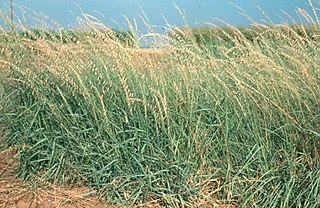
Bouteloua is a genus of plants in the grass family. Members of the genus are commonly known as grama grass.

Beschorneria is a genus of succulent plants belonging to the family Asparagaceae, subfamily Agavoideae, native to semi-arid areas of Mexico and Central America. They are generally large evergreen perennials forming clumps of grey-green leaves, with tall flower-spikes to 1.5 metres (4.9 ft). Marginally hardy, they may require winter protection in areas subject to frost.
- Beschorneria albifloraMatuda - Oaxaca, Chiapas, Guatemala, Honduras
- Beschorneria calcicolaA.García-Mendoza - Puebla, Oaxaca, Veracruz
- Beschorneria dubiaCarrière - Tamaulipas
- Beschorneria rigidaRose - Guanajuato, San Luis Potosí, Puebla
- Beschorneria septentrionalisA.García Mendoza - Tamaulipas, Nuevo León
- Beschorneria tubiflora(Kunth & C.D.Bouché) Kunth - San Luis Potosí, Hidalgo
- Beschorneria wrightiiHook.f - México State
- Beschorneria yuccoidesK.Koch - Hidalgo, Puebla, Veracruz
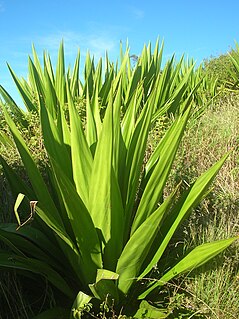
Furcraea is a genus of succulent plants belonging to the family Asparagaceae, subfamily Agavoideae, native to tropical regions of Mexico, the Caribbean, Central America and northern South America. Some species are also naturalized in parts of Africa, Florida, Portugal, Thailand, India, and Australia, as well as on various oceanic islands.

Cascabela is a genus of flowering plants in the dogbane family, Apocynaceae. It is native to Mexico, Central America, and South America.
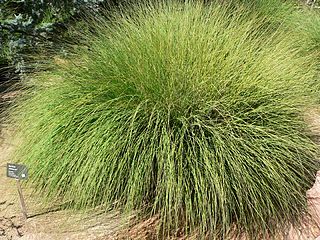
Muhlenbergia is a genus of plants in the grass family.

Symphoricarpos occidentalis, commonly called western snowberry or wolfberry, is a woody species of flowering plant in the honeysuckle family. Wolfberry is not to be confused with Lycium chinense and L. barbarum (goji), which are also known as wolfberry.

Callisia is a genus of flowering plants in the spiderwort family, Commelinaceae. Members of the genus are commonly known as roselings. It is native to the Western Hemisphere from the southern United States to Argentina. The generic name is derived from the Greek word καλλον (kallos), meaning "beauty."

Sorghastrum is a genus of grasses, native to Africa and the Americas.

Hilaria is a genus of North American plants in the grass family. Members of the genus are commonly known as curly mesquite. They are found in the Southwestern United States, Mexico, and Guatemala.
Eremosis is a genus of flowering plants in the daisy family.
- Eremosis heydeana(J.M.Coult.) Gleason - Oaxaca, Chiapas, Guatemala
- Eremosis leiocarpa(DC.) Gleason - Chiapas, Guatemala, Belize, Honduras, El Salvador, Nicaragua
- Eremosis littoralisGleason - Colima
- Eremosis oolepis(S.F.Blake) Gleason - Yucatán, Quintana Roo
- Eremosis pallens(Sch.Bip.) Gleason - Chiapas, México State, Morelos, Guerrero, Nayarit
- Eremosis shannoniiGleason - Chiapas, Guatemala
- Eremosis tarchonanthifolia(DC.) Gleason - Oaxaca
- Eremosis tomentosa(La Llave & Lex.) Gleason Michoacán, Morelos, Mexico State
- Eremosis triflosculosa(Kunth) Gleason - Chiapas, El Salvador
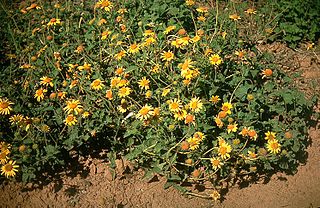
Simsia is a genus of flowering plants in the sunflower tribe within the daisy family. It includes annuals, herbaceous perennials, and shrubs. They range from the western United States south through Central and South America to Argentina, with the center of diversity occurring in Mexico. The genus is named for British physician and botanist John Sims (1749–1831). Although some species are relatively rare, others have become common weeds that line the roadsides and fields of Mexico, often forming dense stands mixed with Tithonia and other Asteraceae. Some species are known by the common name bushsunflower.
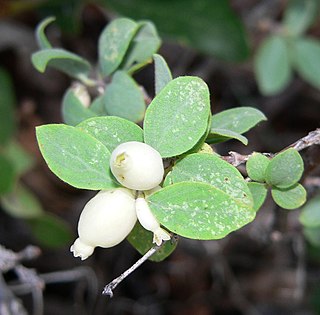
Symphoricarpos oreophilus is a North American species of flowering plant in the Caprifoliaceae, or honeysuckle family, known by the common name mountain snowberry. It has a wide distribution in western Canada, the United States, and northwestern Mexico. It is found in mountainous areas such as the Cascades, the Sierra Nevada, the Rockies, and the Sierra Madre Occidental from British Columbia to the Copper Canyon region of Chihuahua, from the coastal states as far inland as the Black Hills, the Oklahoma Panhandle, and trans-Pecos Texas.
Crusea is a genus of angiosperms in the Rubiaceae family. The genus is found in Arizona, New Mexico, Mexico, and Central America. A few species are naturalized in Cuba and Puerto Rico.
Diastatea is a genus of plants native to Latin America, mostly in Mexico and Central America but with one species extending southward along the Andes to Argentina.
- Diastatea costaricensisMcVaugh - Guatemala, Honduras, Nicaragua, Costa Rica
- Diastatea expansaMcVaugh - central Mexico
- Diastatea ghiesbreghtii(Kuntze) E.Wimm - southwestern Mexico
- Diastatea micrantha(Kunth) McVaugh - widespread from central Mexico to the Jujuy region of northern Argentina
- Diastatea tenera(A.Gray) McVaugh - southern Mexico and Guatemala
- Diastatea virgataScheidw. - southern Mexico
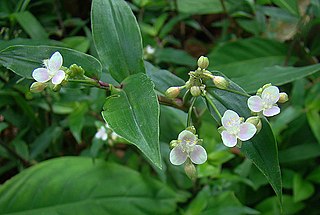
Tripogandra is a genus of flowering plants in the spiderwort family, Commelinaceae. It is native to the Western Hemisphere from central Mexico and the West Indies south to Argentina.
- Tripogandra amplexansHandlos - central + southern Mexico
- Tripogandra amplexicaulis(Klotzsch ex C.B.Clarke) Woodson - central + southern Mexico, Guatemala, Honduras, Nicaragua, Costa Rica
- Tripogandra angustifolia(B.L.Rob.) Woodson - Mexico, Guatemala
- Tripogandra brasiliensisHandlos - eastern Brazil
- Tripogandra disgrega(Kunth) Woodson - Mexico, Guatemala, Honduras, El Salvador
- Tripogandra diuretica(Mart.) Handlos - Brazil, Bolivia, Argentina, Paraguay. Uruguay
- Tripogandra elataD.R.Hunt - Goiás, Brasília
- Tripogandra encolea(Diels) J.F.Macbr. - Bolivia, Ecuador, Peru
- Tripogandra glandulosa(Seub.) Rohweder - Trinidad, Venezuela, French Guiana, Peru, Brazil, Bolivia, Argentina, Paraguay. Uruguay
- Tripogandra guerrerensisMatuda - Guerrero
- Tripogandra ionantha(Diels) J.F.Macbr. - Peru
- Tripogandra kruseanaMatuda - Guerrero
- Tripogandra montanaHandlos - southern Mexico, Guatemala, Honduras, El Salvador
- Tripogandra multiflora(Sw.) Raf. - from southern Mexico south to Argentina, plus Jamaica + Trinidad; naturalized in Azores
- Tripogandra neglectaHandlos - Minas Gerais
- Tripogandra palmeri(Rose) Woodson - western Mexico from Sinaloa south to Guerrero
- Tripogandra purpurascens(S.Schauer) Handlos - from northern Mexico south to Argentina
- Tripogandra saxicola(Greenm.) Woodson - Morelos, Puebla, Guerrero
- Tripogandra serrulata(Vahl) Handlos - central + southern Mexico, Central America, West Indies, northern South America
- Tripogandra silvaticaHandlos - Veracruz
- Tripogandra warmingiana(Seub.) Handlos - Bahia, Minas Gerais, Rio de Janeiro

Cirsium horridulum, called bristly thistle, horrid thistle, yellow thistle or bull thistle, is a North American species of plants in the thistle tribe within the sunflower family. It is an annual or biennial. The species is native to the eastern and southern United States from New England to Florida, Texas, and Oklahoma as well as to Mexico, Belize, Guatemala, Honduras, and the Bahamas.
Symphoricarpos guatemalensis is a Central American species of flowering plant in the honeysuckle family. It has been found only in Guatemala.
Symphoricarpos parishii, or Parish's snowberry, is a North American species of flowering plant in the honeysuckle family. It had been found in California, Nevada, Arizona, and Baja California.
















